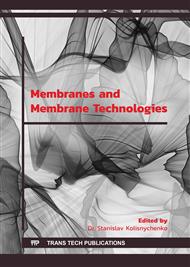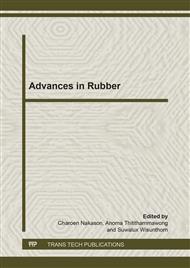p.194
p.198
p.201
p.205
p.209
p.217
p.221
p.225
p.229
Molecular Dynamics Simulation of Gas Transport in Polyisoprene Matrix
Abstract:
Molecular Dynamics (MD) simulation was employed to study the diffusivity of biogas in a PI matrix with the aim to verify simulations as a useful tool to predict PI membrane properties for biogas treatment. The simulation model of PI numerical was reliable and accurate in predicting both the material properties and the diffusivity of gases in PI matrix. The diffusion coefficients (D) of the major components in biogas, namely CH4, CO2, H2O, O2, and N2, were computed by simulating trajectories of each gas in PI matrix at 300 K. The simulations gave DCO2 that was 6 times larger than DCH4, and this agrees well with permeabilities reported in the literature. This suggests that PI membranes could be used to treat biogas by separating CO2 and CH4. However, the diffusivities of N2, H2O, and CH4 are closely similar, so PI membranes are not capable of separating these. The potential application of PI membrane to CO2/CH4 separation seems worth further exploration.
Info:
Periodical:
Pages:
209-213
Citation:
Online since:
November 2013
Authors:
Keywords:
Price:
Сopyright:
© 2014 Trans Tech Publications Ltd. All Rights Reserved
Share:
Citation:



